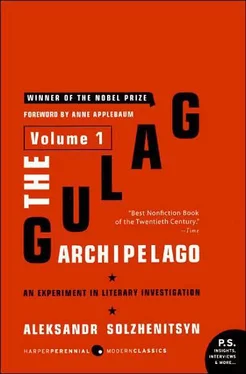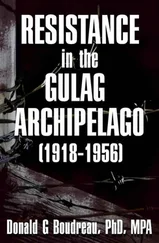Aleksandr Solzhenitsyn - The GULag Archipelago Volume 1 - An Experiment in Literary Investigation
Здесь есть возможность читать онлайн «Aleksandr Solzhenitsyn - The GULag Archipelago Volume 1 - An Experiment in Literary Investigation» весь текст электронной книги совершенно бесплатно (целиком полную версию без сокращений). В некоторых случаях можно слушать аудио, скачать через торрент в формате fb2 и присутствует краткое содержание. Город: New York, Год выпуска: 2007, ISBN: 2007, Издательство: Harper Perennial Modern Classics, Жанр: История, Биографии и Мемуары, dissident, на английском языке. Описание произведения, (предисловие) а так же отзывы посетителей доступны на портале библиотеки ЛибКат.
- Название:The GULag Archipelago Volume 1: An Experiment in Literary Investigation
- Автор:
- Издательство:Harper Perennial Modern Classics
- Жанр:
- Год:2007
- Город:New York
- ISBN:9780061253713
- Рейтинг книги:3 / 5. Голосов: 1
-
Избранное:Добавить в избранное
- Отзывы:
-
Ваша оценка:
- 60
- 1
- 2
- 3
- 4
- 5
The GULag Archipelago Volume 1: An Experiment in Literary Investigation: краткое содержание, описание и аннотация
Предлагаем к чтению аннотацию, описание, краткое содержание или предисловие (зависит от того, что написал сам автор книги «The GULag Archipelago Volume 1: An Experiment in Literary Investigation»). Если вы не нашли необходимую информацию о книге — напишите в комментариях, мы постараемся отыскать её.
“Best Nonfiction Book of the Twentieth Century” (Time magazine ) Review
The GULag Archipelago Volume 1: An Experiment in Literary Investigation — читать онлайн бесплатно полную книгу (весь текст) целиком
Ниже представлен текст книги, разбитый по страницам. Система сохранения места последней прочитанной страницы, позволяет с удобством читать онлайн бесплатно книгу «The GULag Archipelago Volume 1: An Experiment in Literary Investigation», без необходимости каждый раз заново искать на чём Вы остановились. Поставьте закладку, и сможете в любой момент перейти на страницу, на которой закончили чтение.
Интервал:
Закладка:
However, let us return to being dispassionate and impartial once more. Of course, the All-Russian Central Executive Committee would certainly have “completely abolished” the supreme measure, as promised, but unfortunately what happened was that in 1936 the Father and Teacher “completely abolished” the All-Russian Central Executive Committee itself. And the Supreme Soviet that succeeded it had an eighteenth-century ring. “The supreme measure” became a punishment once again, and ceased to be some kind of incomprehensible “social defense.” Even to the Stalinist ear the executions of 1937-1938 could hardly fit into any framework of “defense.”
What legal expert, what criminal historian, will provide us with verified statistics for those 1937-1938 executions? Where is that Special Archive we might be able to penetrate in order to read the figures? There is none. There is none and there never will be any. Therefore we dare report only those figures mentioned in rumors that were quite fresh in 1939-1940, when they were drifting around under the Butyrki arches, having emanated from the high- and middle-ranking Yezhov men of the NKVD who had been arrested and had passed through those cells not long before. (And they really knew!) The Yezhov men said that during those two years of 1937 and 1938 a half-million “political prisoners” had been shot throughout the Soviet Union, and 480,-000 blatnye—habitual thieves—in addition. (The thieves were all shot under Article 59-3 because they constituted “a basis of Yagoda’s power”; and thereby the “ancient and noble companionship of thieves” was pruned back.)
How improbable are these figures? Taking into consideration that the mass executions went on not for two full years but only for a year and a half, we would have to assume (under Article 58—in other words, the politicals alone) an average of 28,000 executions per month in that period. For the whole Soviet Union. But at how many different locations were executions being carried out? A figure of 150 would be very modest. (There were more, of course. In Pskov alone, the NKVD set up torture and execution chambers in the basements of many churches, in former hermits’ cells. And even in 1953 tourists were still not allowed into these churches, on the grounds that “archives” were kept there. The cobwebs hadn’t been swept out for ten years at a stretch: those were the “archives” they kept there. And before beginning restoration work on these churches, they had to haul away the bones in them by the truckload.) On the basis of this calculation, an average of six people were shot in the course of one day at each execution site. What’s so fantastic about that? It is even an understatement! (According to other sources, 1,700,000 had been shot by January 1, 1939.)
During the years of World War II, the use of capital punishment was occasionally extended for various reasons (as, for example, by the militarization of the railroads), and, at times, was broadened as to method (from April, 1943, on, for example, with the decree on hanging).
All these events delayed to a certain extent the promised full, final, and perpetual repeal of the death penalty. However, the patience and loyalty of our people finally earned them this reward. In May, 1947, Iosif Vissarionovich inspected his new starched dickey in his mirror, liked it, and dictated to the Presidium of the Supreme Soviet the Decree on the Abolition of Capital Punishment in peacetime (replacing it with a new maximum term of twenty-five years—it was a good pretext for introducing the so-called quarter).
But our people are ungrateful, criminal, and incapable of appreciating generosity. Therefore, after the rulers had creaked along and eked out two and a half years without the death penalty, on January 12, 1950, a new decree was published that constituted an about-face: “In view of petitions pouring in from the national republics [the Ukraine?], from the trade unions [oh, those lovely trade unions; they always know what’s needed], from peasant organizations [this was dictated by a sleepwalker: the Gracious Sovereign had stomped to death all peasant organizations way back in the Year of the Great Turning Point], and also from cultural leaders [now, that is quite likely],” capital punishment was restored for a conglomeration of “traitors of the Motherland, spies, and subversives-diversionists.” (And, of course, they forgot to repeal the quarter, the twenty-five-year sentence, which remained in force.)
And once this return to our familiar friend, to our beheading blade, had begun, things went further with no effort at all: in 1954, for premeditated murder; in May, 1961, for theft of state property, and counterfeiting, and terrorism in places of imprisonment (this was directed especially at prisoners who killed informers and terrorized the camp administration); in July, 1961, for violating the rules governing foreign currency transactions; in February, 1962, for threatening the lives of (shaking a fist at) policemen or Communist vigilantes, the so-called “druzhinniki”; then for rape; and immediately thereafter for bribery.
But all of this is simply temporary—until complete abolition. And that’s how it’s described today too. [263]
And so it turns out that Russia managed longest of all without capital punishment in the reign of the Empress Elizabeth Petrovna.
In our happy, blind existence, we picture condemned men as a few ill-fated, solitary individuals. We instinctively believe that we could never end up on death row, that it would take an outstanding career if not heinous guilt for that to happen. A great deal has still to be shaken up inside our heads for us to get the real picture: a mass of the most ordinary, average, gray people have languished in death cells for the most ordinary, everyday misdemeanors, and, although some were lucky and had their death sentences commuted, which was purely a matter of chance, they very often got the super (which is what the prisoners called “the supreme measure,” since they hate lofty words and manage somehow to give everything a nickname that is both crude and short).
The agronomist of a District Agricultural Department got a death sentence for his mistaken analysis of collective farm grain! (Maybe it was because his analysis wasn’t what his chiefs wanted from him?) That was in 1937.
Melnikov, the chairman of a handicraft artel that made spools for thread, was sentenced to death because a spark from a steam engine in his artel had caused a fire! That was in 1937. (True, his death sentence was commuted to a “tenner.”)
In that same Kresty Prison in Leningrad, in 1932, two of the men in death cells were Feldman, convicted of possessing foreign currency, and Faitelevich, a student at the conservatory, for having sold steel ribbon for pen points. Primordial commerce, the bread and butter and pastime of the Jew, had also become worthy of the death penalty.
Ought we to be surprised then that the Ivanovo Province village lad Geraska got the death penalty? In honor of the spring St. Nicholas holiday, he went off to the next village to celebrate; he drank heavily and, with a stick, he hit the rear end—no, not of the policeman himself, but of the policeman’s horse. (True, in a rage at the police he ripped a piece of board off the village soviet building and then yanked out the village soviet telephone by the cord, shouting: “Smash the devils!”)
Whether our destiny holds a death cell in store for us is not determined by what we have done or not done. It is determined by the turn of a great wheel and the thrust of powerful external circumstances. For example, Leningrad was under siege and blockade. And what would its highest-ranking leader, Comrade Zhdanov, think if there were no executions among the cases in Leningrad State Security during such difficult times? He would think the Organs were lying down on the job, would he not? Were there not big underground plots, directed from outside by the Germans, to be discovered? Why were such plots discovered under Stalin in 1919 and not under Zhdanov in 1942? No sooner ordered than done. Several ramified plots were discovered. You were asleep in your unheated Leningrad room, and the sharp claws of the black hand were already hovering over you. And yet none of this depended on you. Notice was taken of a Lieutenant General Ignatovsky, whose windows looked out on the Neva; he had pulled out a white handkerchief to blow his nose. Aha, a signal! Furthermore, because Ignatovsky was an engineer, he liked to talk about machinery with the sailors. And that clinched it! Ignatovsky was arrested. The time for reckoning came. Come on now, name forty members of your organization. He named them. And so, if you happened to be an usher at the Aleksandrinsky Theatre, your chances of being named as one of his particular forty were minimal. But if you were a professor at the Technological Institute, there you were on that list (once more, that accursed intelligentsia). So how could it depend on you? To be on such a list amounted to execution for each one.
Читать дальшеИнтервал:
Закладка:
Похожие книги на «The GULag Archipelago Volume 1: An Experiment in Literary Investigation»
Представляем Вашему вниманию похожие книги на «The GULag Archipelago Volume 1: An Experiment in Literary Investigation» списком для выбора. Мы отобрали схожую по названию и смыслу литературу в надежде предоставить читателям больше вариантов отыскать новые, интересные, ещё непрочитанные произведения.
Обсуждение, отзывы о книге «The GULag Archipelago Volume 1: An Experiment in Literary Investigation» и просто собственные мнения читателей. Оставьте ваши комментарии, напишите, что Вы думаете о произведении, его смысле или главных героях. Укажите что конкретно понравилось, а что нет, и почему Вы так считаете.












